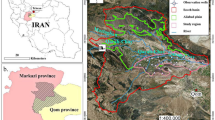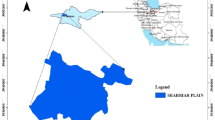Abstract
During the past years, land subsidence due to different reasons such as uncontrolled population growth, overuse of groundwater resources, tectonic and other factors has led to numerous challenges and problems for agricultural lands, residential buildings, roads, power transmission lines, etc. Hence, it is important to monitor the rate of subsidence and address its influencing cause or causes to control and monitor risk. Sentinel-1A data were used in Sentinels Application Platform (SNAP) in this study to examine the subsidence status in the Fahlian aquifer and determine the changes in the land surface in the specified time period. Grace satellite was also used to monitor the changes in the aquifer groundwater fluctuations. OLS model was used to perform spatial analysis of parameters influencing subsidence, the results of which indicated several influencing factors. Accordingly, the greatest impact on land subsidence was related to groundwater drawdown, altitude, and vegetation with probabilities of 0.002, 0.001, and 0.001%, respectively, indicating the significance of the mentioned parameters in the subsidence of the Fahlian aquifer. The output of the CSR, JPL, and CFZ algorithms showed a drawdown trend for the groundwater level since 2009, reaching about 20 cm in 2017.













Similar content being viewed by others
References
Babaee S, Mousavi Z, Masoumi Z, Hojati Malekshah A, Roostaei M, Aflaki M (2020) Land subsidence from interferometric SAR and groundwater patterns in the Qazvin plain, Iran. Int J Remote Sens 41(12). https://doi.org/10.1080/01431161.2020.1724345
Bates RL, Jackson JA (1980) “Glossary of Geology.” American Geological Institute, Second edition, Falls Church, Virginia, 749 p
Cao J, Ma F, Guo J, Lu R, Liu G (2019) Assessment of mining-related seabed subsidence using GIS spatial regression methods: a case study of the Sanshandao gold mine (Laizhou, Shandong Province, China). Environ Earth Sci 78(26). https://doi.org/10.1007/s12665-018-8022-1
Erfanian M, Hossein Khah M, Alijanpoor A (2013) Introduction to multivariate OLS and GWR regression methods in spatial modeling of land use effects on water quality. J Watershed Manag Promot Dev 1(1). https://doi.org/10.22059/JES.2016.58738
Faunt C, Sneed M, Traum J, Brandt R (2015) Water availability and land subsidance in the Central Valley. California USA Hydrogeol J Spring 15(3):452–470. https://doi.org/10.1007/s10040-015-1339-x
Francesc P, Tapete D (2021) Satellite InSAR survey of structurally-controlled land subsidence due to groundwater exploitation in the Aguascalientes Valley, Mexico. Remote Sens Environ 254 https://doi.org/10.1016/j.rse.2020.112254
Gabriel AK, Goldstein RM, Zebker HA (1989) Mapping small elevation changes over large areas - differential radar interferometry. J Geophys Res 94(B7):9183–9191. https://doi.org/10.1029/JB094iB07p09183
Gallowey DL, Burbey TJ (2011) Regional land subsidence accompanying groundwater extraction. Hydrogeol J 19:1459–1486. https://doi.org/10.1007/s10040-011-0775-5
Ghazavi R, Ramazani Sarbandi M (2017) Investigation of the effects of precipitation change and groundwater overextraction on both quantitative and qualitative changes of groundwater (Rafsanjan Plain). Q J Hydrogeomorphol 12:111–129 ((in Persian))
Helm DC, Looney BB, Falta RW (2000) Fissures in Yucca Flat dry lake bed, Nevada test site. Vadose Zone, Science and Technology Solutions. Battelle Press, Columbus, OH [CD-ROM.]
Khorrami M, Alizadeh B, Ghasemi Tousi E, Shakerian M, Maghsoudi M, Rahgozar P (2019) How groundwater level fluctuations and geotechnical properties lead to asymmetric subsidence: A PSInSAR analysis of land deformation over a transit corridor in the LosAngeles Metropolitan area. Remote Sens J 11(4):257–270. https://doi.org/10.3390/rs11040377
Larson KJ, Basaglu H, Marino MA (2001) Predication of optimal safe ground water yield and land subsidence in Los Banos Kettleman citty area, using a calibrated numerical simulation model. J Hydrol 242:79–102. https://doi.org/10.1016/S0022-1694(00)00379-6
Lin B, Liming J, Hansheng W, Qishi S (2016) Spatiotemporal Characterization of Land Subsidence and Uplift (2009–2010) over Wuhan in Central China revealed by TerraSAR-X InSAR analysis, 8(4): 350. https://doi.org/10.3390/rs8040350
Nasiri A, Shafiei N, Farzin Kia R (2021) Investigation of Fahlian aquifer subsidence and its effect on groundwater loss. Arab J Geosci 14:637. https://doi.org/10.1007/s12517-021-06917-7
Putra DPE, Setianto A, Keokhampui K, Fukuoka H (2011) Land Subsidence Risk Asseessment in Karst Region, Case Study : Rongkop, Gunung Kidul, Yogyakarta-Indonesia. In: Mitteilungen zur Ingenieurgeologie und Hydrogeologie-Festschrift zum 60.Geburtstag von Univ.-Prof.Dr.Dr.h.c.Rafig Azzam. RWTH Aachen University, German, 39–50. https://repository.ugm.ac.id/id/eprint/134971
Raspini F, Loupasakis C, Rozos D, Adam N, Moretti S (2014) Ground subsidence phenomena in the delta municipality region (Northern Greece): geotechnical modeling and validation with persistent scatterer interferometry. Int J 28:78–89. https://doi.org/10.1016/j.jag.2013.11.010
Rokni J, Hossinzadeh R, Lashkaripour GR, Velayati S (2016) Land subsidence, perspectives, and geomorphology developments in the denser plains, case study: Neyshabour Plain. Arid Reg Geogr Stud 6 (24): 21–38. http://journals.hsu.ac.ir/jarhs/article-1-929-en.html
Shafiei N, Goli Mokhtari L, Amir Ahmadi A, Zandi R (2020) Investigation of subsidence of Noorabad Plain aquifer using Radar Interferometry Method. J Quant Geomorphol Res 8(4):93–111
Shayan S, Yamani M, Yadegari M (2016) Zoning of the land subsidence in the Hamedan Qarachai Watershed. Hydrogeomorphology 9:139–158 (in Persian)
Sharifikia M (2012) Land Subsidence Rate and Area Assessment in Nogh Bahramanplain Based on D-Insar Technique. Spatial Planning (Modares Human Sciences) Fall 16(3):55–77. (in Persian)
Smith RG, Knight R, Chen J, Reeves JA, Zebker HA, Farr T, Liu Z (2017) Estimating the permanent loss of groundwater storage in the southern San Joaquin Valley. California Water Resour Res J 53(2):147–163. https://doi.org/10.1002/2016WR019861
Sun H, Grandstaff D, Shagam R (1999) Land subsidence due to groundwater Withdrawal: potential damage of subsidence and sea level ruse in southern New Jersy. USA Environ Geol37(4) April 1999 7 Q Springer-Verlag, 290–296. https://doi.org/10.1007/s002540050386
Zandi R, Farzinkia R, Shafiee N (2019) Subsidence and Radar Interferometry. Mahvareh Publishing. (in Persian)
Zebker HA (2000) Studying the earth with interferometric radar. Comput Sci Eng 2(3):52–60. https://doi.org/10.1109/5992.841796
Author information
Authors and Affiliations
Corresponding author
Additional information
Communicated by: H. Babaie
Publisher’s note
Springer Nature remains neutral with regard to jurisdictional claims in published maps and institutional affiliations.
Rights and permissions
About this article
Cite this article
Nasiri, A., Shafiee, N. & Zandi, R. Spatial analysis of factors influencing land subsidence using the OLS Model (Case Study: Fahlian Aquifer). Earth Sci Inform 14, 2133–2144 (2021). https://doi.org/10.1007/s12145-021-00688-1
Received:
Accepted:
Published:
Issue Date:
DOI: https://doi.org/10.1007/s12145-021-00688-1




